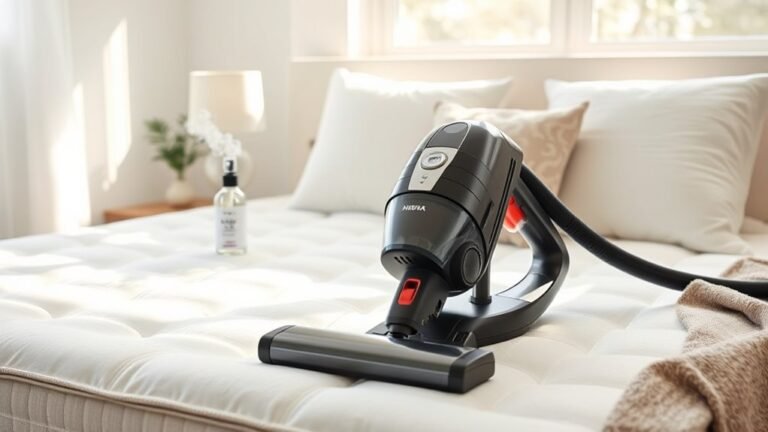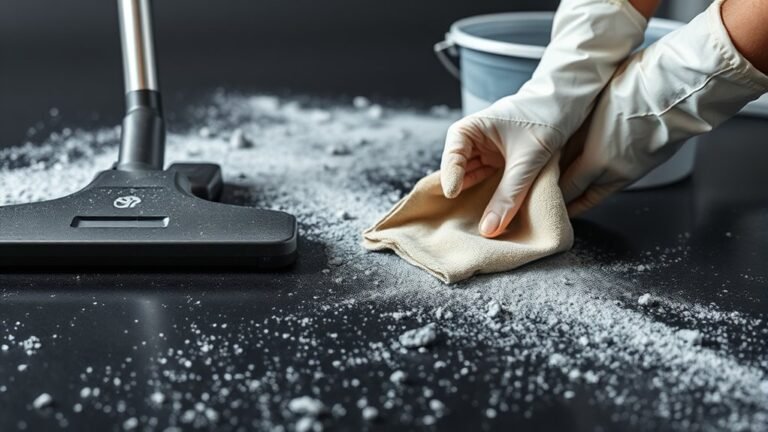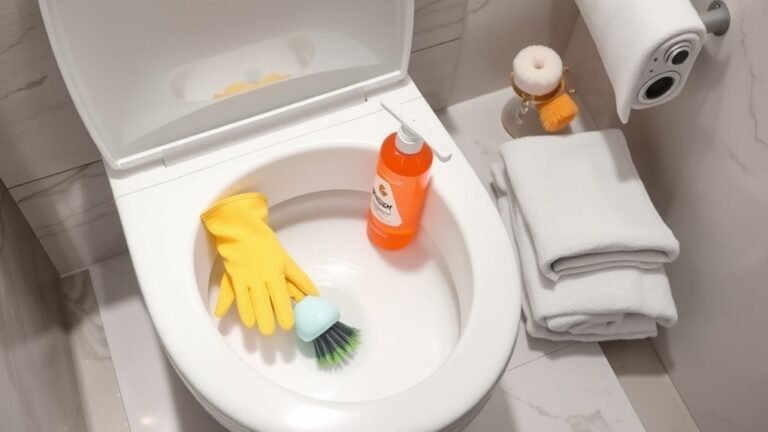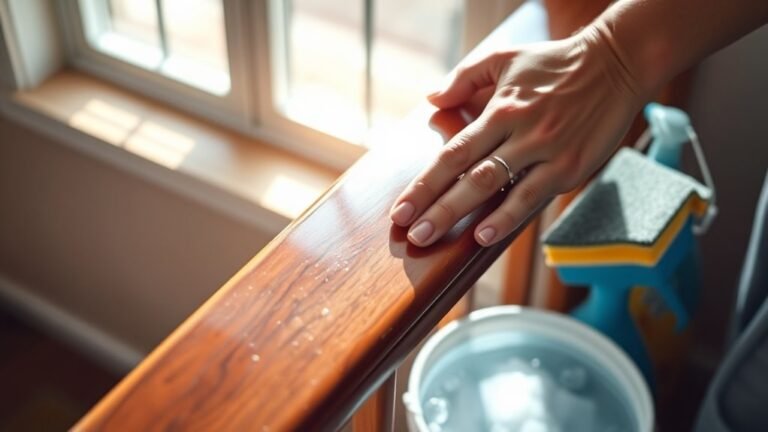Mistakes to Avoid When Cleaning Your Allergens
You’re likely making mistakes that let allergens thrive despite your cleaning efforts. Using dry dusting methods stirs up dust instead of removing it, while ignoring air filters and HVAC upkeep traps irritants indoors. Don’t overlook soft furnishings that harbor allergens or rely on harsh chemicals without proper ventilation, which can worsen symptoms. Neglecting pet areas and skipping ventilation after cleaning only adds to the problem. Keep going to discover how to truly reclaim a healthier, allergen-free space.
Using Dry Dusting Methods

One common mistake people make when cleaning allergens is relying on dry dusting methods. While it may seem quick and easy, dry dusting often just stirs up dust and allergens, causing allergen accumulation rather than removal. If you want true freedom from sneezing fits and irritated lungs, you’ve got to get smart about how you clean. Instead of dry dusting, use a damp cloth or microfiber wipes that trap particles without sending them airborne. This simple shift can dramatically reduce allergens lingering in your space, giving you cleaner air and more freedom to breathe easy. Don’t let dry dusting hold you back—choose methods that actually capture allergens and help reclaim your environment.
Ignoring Air Filters and HVAC Systems
You can’t overlook your air filters and HVAC system when tackling allergens. Regularly replacing filters and scheduling maintenance are key to keeping your air clean and reducing irritants. Neglecting these tasks lets allergens circulate, undoing your cleaning efforts.
Filter Replacement Frequency
Several factors can affect how often you need to replace filters beyond just air filters and HVAC systems. Your filter lifespan depends on usage, environment, and the type of filter you choose. For example, if you have pets or allergies, dust and dander accumulate faster, requiring more frequent changes. Ignoring ideal timing can let allergens build up, reducing air quality and your freedom to breathe easy. Keep an eye on the manufacturer’s guidelines but also trust your senses—if you notice dust or odors, it’s time to swap filters. Staying on top of filter replacement isn’t about strict schedules; it’s about keeping your space fresh and allergen-free so you can enjoy your home without unnecessary restrictions.
HVAC Maintenance Importance
Although it might seem minor, ignoring regular HVAC maintenance can seriously impact your home’s air quality and allergen levels. Skipping HVAC inspections means you miss out on catching issues that trap dust, pollen, and other allergens inside your system. When your HVAC system isn’t running efficiently, these particles circulate freely, limiting your freedom to breathe clean air indoors. Staying on top of system upgrades not only boosts performance but also reduces allergens by improving filtration and airflow. Don’t let neglect hold you back—routine maintenance keeps your HVAC system in top shape, helping you enjoy a healthier, allergen-reduced environment. Taking control with timely inspections and upgrades is one of the smartest moves you can make for your home’s comfort and your well-being.
Air Quality Impact
Ignoring air filters and HVAC systems can drastically reduce your home’s air quality, letting allergens like dust, pollen, and pet dander circulate unchecked. When you skip regular air filter changes, airborne particles build up and spread throughout your living space, increasing exposure to indoor pollutants. This not only triggers allergies but also compromises your freedom to breathe easy in your own home. Maintaining your HVAC system and swapping out filters on schedule is essential for trapping these irritants before they take over. Don’t let neglect hold you hostage to sneezing fits or respiratory discomfort. Taking control of your air quality means actively managing airborne particles and indoor pollutants, so you can enjoy a clean, allergen-free environment without restrictions. Your health and comfort depend on it.
Overlooking Soft Furnishings and Upholstery
One of the biggest mistakes you can make when cleaning allergens is overlooking soft furnishings and upholstery. These surfaces trap dust, pet dander, and pollen, turning your relaxing space into a hidden allergen hotspot. To keep your freedom from allergies intact, focus on:
- Regular upholstery cleaning to remove embedded allergens.
- Using fabric protection sprays to create a barrier against dust and spills.
- Vacuuming sofas and cushions with a HEPA filter-equipped vacuum.
- Washing removable covers frequently in hot water.
Don’t let soft furnishings sabotage your clean-air sanctuary. Proper care here guarantees you breathe easier and enjoy your home without restrictions.
Using Harsh Chemicals Without Proper Ventilation
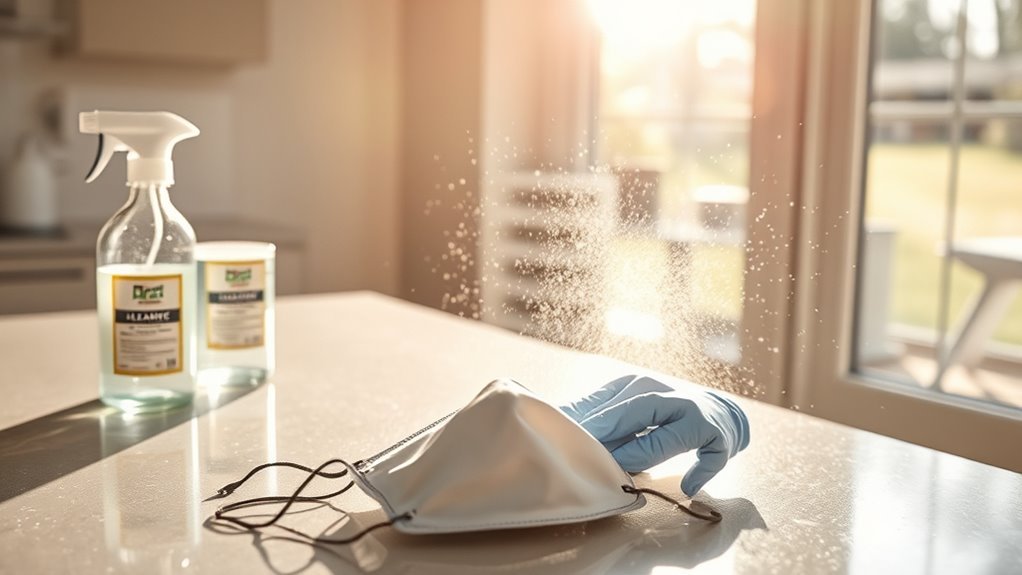
If you don’t guarantee proper ventilation when using harsh chemicals, you could worsen your allergy symptoms instead of improving them. These substances release fumes that irritate your respiratory system, trapping you in discomfort rather than freeing you from allergens. To maintain your freedom to breathe easy, always open windows and doors or use fans to circulate fresh air. Consider ventilation techniques like cross-breezes or exhaust fans to reduce harmful exposure.
Instead of relying solely on harsh chemicals, explore safer chemical alternatives such as natural sprays or vinegar solutions that effectively tackle allergens without the toxic aftermath. By combining smart ventilation techniques with gentler cleaning agents, you protect your health and enjoy a truly allergen-free space without sacrificing your well-being or freedom.
Neglecting Regular Cleaning of Pet Areas
When you skip regular cleaning of pet areas, allergens like dander, fur, and dust build up quickly, making your allergy symptoms worse. Staying on top of pet grooming and cleaning helps you control allergens without feeling trapped by constant discomfort. To maintain freedom and comfort, focus on these key steps:
Regular pet area cleaning prevents allergen buildup, easing symptoms and keeping your home comfortable and free from discomfort.
- Vacuum pet bedding and surrounding areas at least twice a week.
- Brush your pet regularly to reduce shedding and dander spread.
- Wash pet toys and blankets frequently in hot water.
- Use allergen-control sprays or wipes designed for pet areas.
Skipping Proper Ventilation After Cleaning
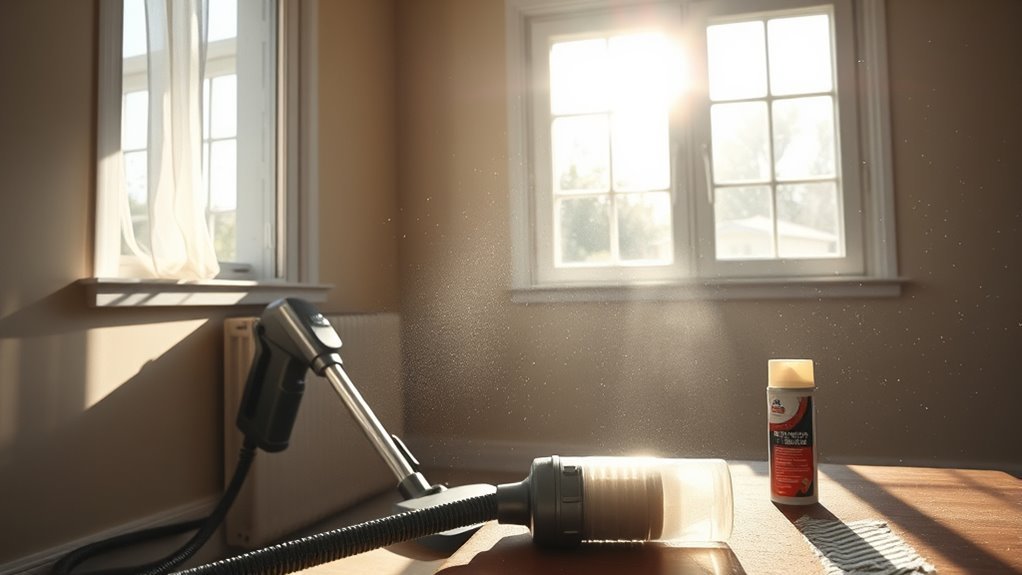
Failing to properly ventilate your home after cleaning can trap allergens and cleaning chemicals in the air, worsening your symptoms. You want to feel free to breathe easy, so don’t skip essential ventilation techniques. Open windows and doors to encourage fresh air to flow through your space, boosting air circulation and pushing out lingering irritants. Using fans strategically can speed up this process, ensuring stale air doesn’t stick around. Remember, cleaning isn’t just about removing allergens from surfaces—it’s also about clearing the air you breathe. Without proper ventilation, you risk sealing in dust, mold spores, and harsh chemical fumes, limiting your freedom from allergy discomfort. Make ventilation a non-negotiable part of your routine for a truly allergen-free home.
Frequently Asked Questions
How Often Should I Replace My Vacuum Cleaner’S HEPA Filter?
You should replace your vacuum cleaner’s HEPA filter every 6 to 12 months, depending on usage. Following a proper filter replacement schedule is key to keeping your vacuum working efficiently and your home allergen-free. Regular vacuum maintenance tips, like checking filters monthly and cleaning them if reusable, help extend their life. Sticking to this routine lets you enjoy a cleaner space without feeling tied down by constant upkeep.
Can Natural Cleaning Products Reduce Allergen Buildup Effectively?
You might wonder if natural solutions can reduce allergen buildup effectively. While they’re great for avoiding harsh chemicals and offer a sense of freedom in your cleaning routine, their cleaning efficiency can vary. Some natural products work well for light dust and pollen, but they may not tackle stubborn allergens like mold or pet dander as thoroughly as specialized cleaners. It’s smart to balance natural options with effective tools for the best results.
Is It Necessary to Wear a Mask While Cleaning Allergens?
It just so happens that wearing a mask while cleaning allergens offers surprising mask benefits you might not expect. When you’re tackling dust or mold, a mask protects your lungs from irritants, making cleaning precautions more effective and safe. You’ll feel freer knowing you’re reducing exposure without sacrificing your health. So, if you want to keep breathing easy and enjoy your space without restrictions, wearing a mask is definitely worth it.
How Do Humidity Levels Affect Allergen Presence in My Home?
Humidity levels play a big role in allergen presence, so managing humidity control is key. When humidity’s too high, it creates a perfect environment for mold and dust mites, common allergen types, to thrive. Too low, and you might irritate your respiratory system, making you more sensitive. You’ll want to keep humidity between 30-50% to keep those allergens in check and enjoy a freer, healthier home atmosphere.
Are There Specific Cleaning Tools Recommended for Allergy Sufferers?
Imagine battling dust with a feather duster that just moves allergens around—frustrating, right? You want allergen-free tools that trap particles, like microfiber cloths and vacuum cleaners with HEPA filters. Effective dusters capture dust without scattering it, giving you freedom from sneezing fits and congestion. Choosing the right gear empowers you to reclaim your space, making your home a sanctuary where breathing easy isn’t a luxury but a daily reality.



